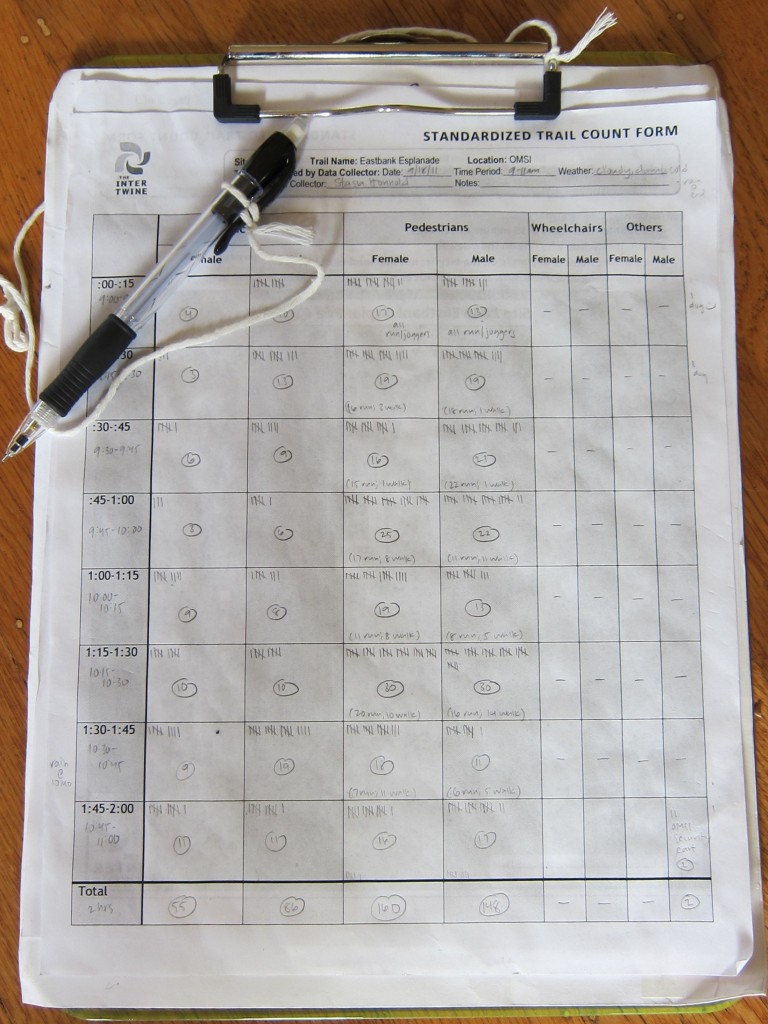What’s a girl to do with her time on a Sunday morning? If you’d asked me a few days ago, it was a fine time to go hunker down along the Esplanade by OMSI for two hours and keep a tally–in 15 minute increments–of who went by on the trail.
Every year, Metro, the regional governmental body here (larger than city government, smaller than state) does a city-wide count of trail and road users. On their website, they explain that they use this sort of info to “support funding requests, planning, and development, and to better understand the region’s overall feelings and values about trails.” I guess automobile use has been tracked and documented for many years, but counting pedestrians and cyclists is relatively new–but it can give us a lot of important data as we move forward creating ped- and bike-friendly spaces.
The official counting sheet looked something like this:
Every time someone went by, I put a tally mark in the appropriate spot, whether they were a pedestrian, cyclist, wheelchair user, or “other” (I did actually have an “other”: two men who rode by in an OMSI security cart), and whether they were male or female. Every 15 minutes I started a new row of tallying, then at the end of two hours, I totaled everything up for a two-hour snapshot of trail use.
I wish you could actually see the end results in this picture, and I wish I knew what the data from other people counting around the city at the same time looked like. But from my own little two-hour snippet of trail use, it seems that there are, indeed, many more male than female cyclists–something that I often hear but don’t totally believe, at least not in the summer (though for whatever reason, in the winter many of the women cyclists do seem to disappear). For 55 women, there were 86 men. And this is not on the street, mind you, this is a super-safe, automobile-free, riverside multi-use path. If women are the “indicator species” of cyclists–appearing only when it is very safe, as many people have hypothesized–then what does it say that they’re still underrepresented on even the safest of paths? It made me a little sad every time I had to mark down yet another male tally mark.
On the other hand, there were more women pedestrians than men. For 160 women, there were only 148 men–not as big a gap as the bicycling gender gap, but noticeable. And I should mention that when I say “pedestrians,” I mostly mean “joggers.” Only 47 of those women and 46 men were actually walking–the rest were out for their morning run.
So from two hours of observation on a Sunday morning, which I will now extrapolate to life in general even though it’s probably not entirely appropriate, it seems that while women will jog with the best of them, they’re still pretty underrepresented in cycling. James had a theory that it’s about body image, that women will jog because it’s supposed to keep you looking trim, whereas biking is not quite the same sort of exercise–or rather, to get the same exercise benefits from biking as from running, you’d have to be going for hours at a time. I’m not sure if that’s true or not, but I’m willing to entertain it as a possible explanation.
It’s also possible that since it was a rainy Sunday, women were less psyched to be outside (or whatever it is that keeps women cyclists inside during the winter). Or maybe a weekend morning is when many women are chilling at home with their kiddos? I have no idea.
So I’m sending my data back to Metro tomorrow, where someone will enter it into a computer, compile it with other trail use data, look at it in conjunction with data from all over Portland, Gresham, and other Metro cities, and will come to some sorts of conclusions about what we should be doing to expand transportation options around here. I’m keeping my eyes out.

